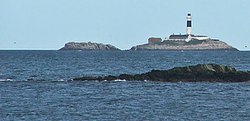Rockabill
| Rockabill | |
 Rockabill Lighthouse | |
|---|---|
| Location | |
| Location: | 53°35’51"N, 6°0’14"W |
| Data | |
Rockabill (Irish: Carraig Dábhiolla, meaning "Two-bill Rock") is a group of two islands, "The Rock" and "The Bill", lying in the western Irish Sea about 4 miles east-north-east of Skerries, County Dublin. An alternative Irish name, Carraig Dhá Bheola, meaning Two Lips Rock, is probably just a corruption of Carraig Dábhiolla.
The two granite islands are separated by a channel about 22 yards wide. On the Rock stands a lighthouse, built in 1855–1860 from granite and limestone and automated in 1989, and there are several walls and outbuildings. These walled areas have enabled a build-up of soil and the establishment of vegetation, notably tree mallow (Lavatera arborea), which provides nesting cover for the birds. The smaller Bill has very little vegetation.
Rockabill is an important seabird breeding island, especially notable for its terns. It is an internationally important site for Roseate Terns, with the largest colony in Europe, over 600 pairs in 2003. There are similar numbers of Common Terns, and other seabirds include Black Guillemots and Black-legged Kittiwakes.
Rockabill is owned by the Commissioners of Irish Lights and is a Refuge for Fauna and a Special Protection Area under the European Union Birds Directive. Since 1989, when the protection afforded by the lighthouse keepers ceased, the islands have been managed by BirdWatch Ireland.
Lighthouse
In 1837 the Drogheda Harbour Commissioners proposed that a lighthouse be built on Rockabill, with the costs to be paid by tolls on the shipping using Drogheda harbour. In 1838, Trinity House, which was then in charge of lighthouses in Ireland, declined the request. In 1853 however the Trinity Board reversed its decision and authorized the construction of the lighthouse. Construction began in 1855 under the supervision of the Burgess brothers, William and James, who were builders from Limerick. The lighthouse tower was built of grante granite from the Mourne Mountains in County Down and local limestone from Milverton. The total cost of all buildings and equipment was £13,248.[1] The light was placed into operation on 1 July 1860.[1]
The focal plane of the lantern is 148 feet above the sea. The round lighthouse tower is built of granite and is 105 feet high, including the lanternhouse and gallery. The light tower is painted white with one broad black horizontal band. In 1918, the station is also equipped with a fog horn.[1] A keeper's residence and other buildings are located at the station, which is operated by the Commissioners of Irish Lights. The lighthouse was automated in March 1989.[1]